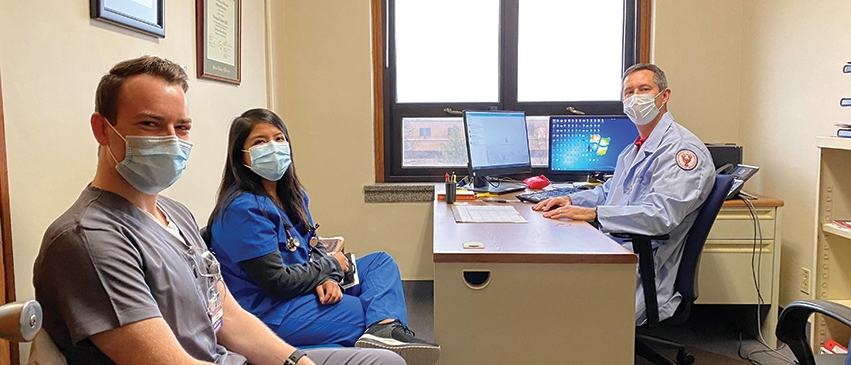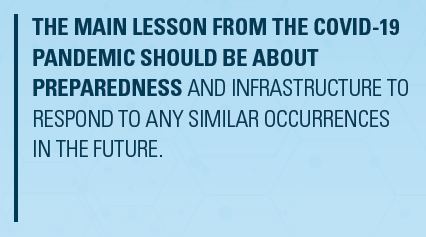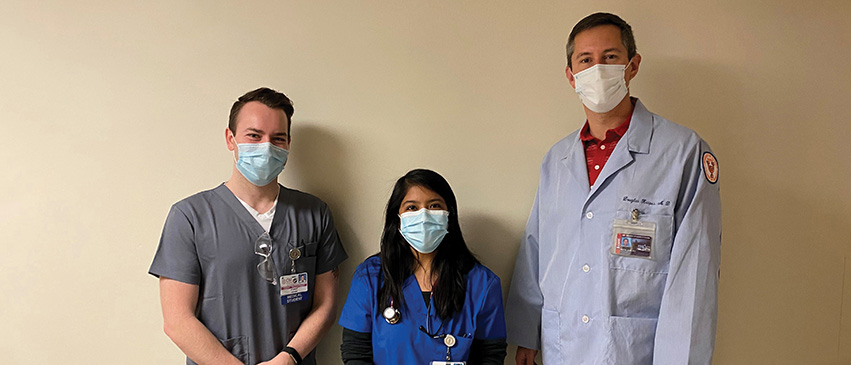Douglas Kasper, MD, MPH, is assistant professor of clinical medicine and section chief – infectious disease with the University of Illinois College of Medicine Peoria. After earning his MD from Loyola University Chicago Stritch School of Medicine, he completed his internal medicine residency at Loyola University Medical Center and served as associate chief resident. He then completed an infectious disease fellowship at Medical College of Wisconsin, where his research focused on microbiology laboratory techniques. Since joining the UICOMP faculty in 2013, he has been honored for teaching excellence and is credited with numerous peer-reviewed publications, posters/abstracts and clinical trials. Peoria Magazine sat down with Dr. Kasper to discuss how the COVID-19 pandemic response rolled out locally; what differentiates the different vaccine candidates; and how we can better respond to future pandemics.
We initially heard about the pandemic as it affected other countries and then large U.S. cities. How did it initially surface in Peoria, and how has it evolved since then?
The COVID-19 pandemic began in the U.S. in late January 2020. By mid-March, a significant number of cases were diagnosed in Illinois, leading to the stay-at-home order by Governor Pritzker. The majority of Illinois’ SARS-CoV-2 cases in March were in Chicago and the surrounding suburbs; the number of confirmed cases in central Illinois was minimal. Infection rates remained low throughout the summer, but began to increase after the transition to reopening. The initial period of shutdown, even with low cases, was important for our medical system to complete strategic planning for the management of COVID-19 infections.
The situation in central Illinois has changed tremendously in recent months. Daily case numbers have increased at a rapid rate, but even more concerning are the increases in hospitalized patients with acute illness from SARS-CoV-2 infection, as well as mortality rates. This surge has been seen throughout the country, with some of the highest rates in central Illinois over the last two months. The response from state and local leadership has required maximizing decisions to induce social distancing. This includes the temporary transition of schools to e-learning, not resuming high school sports, no indoor dining/bars, and recommending against group gatherings of more than 10 people.
What key tactics or strategies have helped control and mitigate the spread of COVID-19?
The response to COVID-19 in central Illinois has required coordination with every aspect of our community. Medical, political, educational, food service and social services have been vital to enacting quick policy changes to deal with the many effects of the pandemic. Specific examples include multiple options for public testing for SARS-CoV-2 infection, including at OSF HealthCare, UnityPoint Health, UICOMP and the Illinois Department of Public Health (IDPH). Lab testing has been vital not only for prompt diagnoses, but to allow uninfected individuals to be cleared to obtain necessary medical treatments, return to school/college, or allow for the resumption of social services programs.
The medical systems have aided in the creation of telemedicine services and pandemic hotlines to continue with baseline medical care while allowing rapid dissemination of new information on COVID-19 progress. UICOMP has been able to continue with the medical education of students, residents and fellows, while providing key support for infrastructure at both OSF and UnityPoint hospital systems.
How has healthcare delivery changed since March, and what does that mean for providers and patients?
In addition to greater use of telehealth and hotline services, medical providers and patients have had to rapidly adapt to allow for medical care to continue with minimal interruption. This has been especially challenging for patients with chronic medical conditions, people with disabilities, and those living in rural areas. Changes in policy (masking, distancing, handwashing) have required clear and consistent communication with medical staff and patients, with consistent reinforcement from the Governor and IDPH. It is challenging to rapidly change many longstanding systems, but the overall commitment to making educated decisions and adhering to science-driven policy has been paramount to the ongoing challenges of the pandemic.
What exactly is “herd immunity,” and how do we achieve it?
Herd immunity is a concept that relates to an infection occurring naturally in a population. As the infection spreads, the “herd” becomes ill and then develops an immune response. When a sufficient number within the herd have become ill, it becomes more challenging for the virus to find another candidate to infect. At that threshold, the virus rates start to decline because no new hosts are available. The concern with herd immunity is that the herd must become infected to generate the immune response. When the herd is a large population, the chances for a poor outcome from infection increase by the overall number of infections that have to occur to reach the threshold.

What developments need to happen for us to reach the endpoint of the pandemic?
Two main strategies are occurring in tandem to lead to an end to the COVID-19 pandemic. The first strategy is to comply with social distancing, masking and handwashing to drive an immediate decline in new infections. This strategy has been consistent since last March, but is even more important given the surge in cases in recent months.
The second strategy is vaccine development to protect the population from becoming infected. The Pfizer-BioNTech mRNA COVID-19 vaccine achieved FDA Emergency Use Authorization on December 11, 2020, while the Moderna vaccine achieved the same approval one week later. Multiple other vaccines are completing the final phase of clinical testing prior to consideration of approval from the FDA. It appears that patients will have multiple vaccine options in 2021 to allow for successful protection from the severe effects of COVID-19 infection.
Even with successful vaccine development and approval, it is likely that SARS-CoV-2 will continue to circulate throughout the world in the future. Vaccine data for prolonged protection are unlikely to be known immediately, and some percentage of people may not respond to the vaccine. While the current situation is likely to dramatically improve in the coming months, a complete resolution is unlikely.
Review of vaccine data across a large cohort of people guide FDA approval and usage recommendations. The FDA has a strict policy for review to share outcomes on utility, safety and specifics of administration to all members of our community. Given the rapid nature of vaccine development, interpretation of clinical trial results are scrutinized by scientists around the world. Vaccine candidates that are approved after sufficient review will have met the highest standards possible for public use.
What should we know about vaccine development and approval as we hit that milestone? What differentiates the vaccines from one another? What is unique about the mRNA vaccines?
The first key step in the SARS-CoV-2 pandemic response timeline was the isolation of genetic material that makes the virus unique from other common coronaviruses. While the novel nature of the virus is what has caused vulnerability for infection in humans, it also offers potential targets for both therapeutics and vaccine development.
 Researchers were able to map the genetic sequence of SARS-CoV-2 and determine the specific portion that encoded for the spike protein, the key element required for the virus to attach to human cells. Through laboratory studies, it was also determined that the spike protein can elicit an immune response. While the immune response is not immediate, when sufficiently present, it provides protection from infection by blocking the spike protein from initiating attachment to host cells.
Researchers were able to map the genetic sequence of SARS-CoV-2 and determine the specific portion that encoded for the spike protein, the key element required for the virus to attach to human cells. Through laboratory studies, it was also determined that the spike protein can elicit an immune response. While the immune response is not immediate, when sufficiently present, it provides protection from infection by blocking the spike protein from initiating attachment to host cells.
The Pfizer-BioNTech and Moderna vaccines are based on injecting a specific SARS-CoV-2 messenger RNA sequence into recipients. Messenger RNA (mRNA) is a template that instructs human cells to create proteins. The mRNA sequence in both vaccines instructs our cells to create the spike protein of SARS-CoV-2; our immune system then recognizes the spike protein as foreign, and a protective immune response is generated. In the future, if natural exposure to SARS-CoV-2 occurs, the immune response occurs much more quickly and the severe effects of COVID-19 infection do not occur.
It is important to note that the Pfizer and Moderna vaccines do not contain any whole or live SARS-CoV-2 virus, and neither vaccine can cause COVID-19 infection. Both vaccines require two dose administrations and confer protective effects in more than 90 percent of people who complete the series. Side effect rates for both vaccines were low and similar in severity to other common vaccines (influenza). The vaccines were developed quickly, but that is due to the robust worldwide commitment from science and industry to combat the pandemic. Additionally, mRNA vaccine research for Zika, rabies and influenza had previously been attempted, allowing researchers to draw on prior studies for expedited development.
There are many other vaccine candidates that continue to go through worldwide clinical trials. Many of them are not mRNA-based options. If other vaccine candidates are shown to be safe and effective, it will only enhance the ability to continue with mass vaccination strategies across the world.
How has COVID-19 followed the “textbook” features of a pandemic? How has it differed?
There is no formal education on pandemics during medical school, residency, fellowship or clinical career. The medical community is rapidly learning (along with the public) the best strategies to move forward with multiple areas within our region. I would highlight the importance of vetted scientific opinion relayed to our population in a non-biased fashion as a unique challenge that is occurring with COVID-19. Social media, social justice, political changes, economic instability and education alterations across the nation and the world have added significantly to how COVID-19 information and policy have been received.
How can we better prevent future pandemics from happening?
Viruses evolve at a much quicker rate than humans. This is due to many reasons, but primarily that viruses can rapidly replicate in many different species. This ability to jump across species allows the virus to make changes that favor its survival by enhancing replication and avoiding the host immune response. This represents virus evolution and is not easily amenable to preventative measures.
The understanding that viruses will continue to change predicts that novel virus strains will be part of our future. This does not mean that all novel virus strains lead to human disease, or that circumstances are always right for a pandemic. The main lesson from the COVID-19 pandemic should be about preparedness and infrastructure to respond to any similar occurrences in the future. This includes understanding healthcare at both the local and national levels to address risk factors and barriers that can hinder aid to the most vulnerable. Pandemics disproportionately impact those who have the least. Raising up all parts of our community during times of health and prosperity will go a long way to a successful pandemic response in the future. PM




